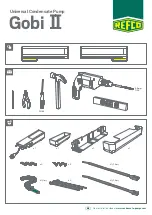
10 About the system
Installation and operation manual
28
RXYSQ4~6TAY1B
VRV IV-S system air conditioner
4P482256-1 – 2017.03
For the user
10
About the system
The indoor unit part of VRV IV-S heat pump system can be used for
heating/cooling applications. The type of indoor unit which can be
used depends on the outdoor units series.
NOTICE
Do not use the system for other purposes. In order to avoid
any quality deterioration, do not use the unit for cooling
precision instruments, food, plants, animals or works of art.
NOTICE
For future modifications or expansions of your system:
A full overview of allowable combinations (for future
system extensions) is available in technical engineering
data and should be consulted. Contact your installer to
receive more information and professional advice.
INFORMATION
▪ Combination of VRV DX and RA DX indoor units is not
allowed.
▪ Combination of RA DX and AHU indoor units is not
allowed.
▪ Combination of RA DX and aircurtain indoor units is not
allowed.
10.1
System layout
g
d
d
c
c
f
e
b
a
g
f
e
a
VRV IV-S Heat pump outdoor unit
b
Refrigerant piping
c
VRV direct expansion (DX) indoor unit
d
User interface (dedicated depending on indoor unit type)
e
BP box (required to connect Residential Air (RA) or Sky Air
(SA) direct expansion (DX) indoor units)
f
Residential Air (RA) direct expansion (DX) indoor units
g
User interface (wireless, dedicated depending on indoor
unit type)
11
User interface
CAUTION
Never touch the internal parts of the controller.
Do not remove the front panel. Some parts inside are
dangerous to touch and appliance problems may happen.
For checking and adjusting the internal parts, contact your
dealer.
This operation manual will give a non-exhaustive overview of the
main functions of the system.
Detailed information on required actions to achieve certain functions
can be found in the dedicated installation and operation manual of
the indoor unit.
Refer to the operation manual of the installed user interface.
12
Operation
12.1
Operation range
Use the system in the following temperature and humidity ranges for
safe and effective operation.
Cooling
Heating
Outdoor
temperature
–5~46°C DB
–20~21°C DB
–20~15.5°C WB
Indoor
temperature
21~32°C DB
14~25°C WB
15~27°C DB
Indoor humidity
≤80%
(a)
(a)
To avoid condensation and water dripping out of the unit. If
the temperature or the humidity is beyond these conditions,
safety devices may be put in action and the air conditioner
may not operate.
Above operation range is only valid in case direct expansion indoor
units are connected to the VRV IV-S system.
Special operation ranges are valid in case of using AHU. They can
be found in the installation/operation manual of the dedicated unit.
Latest information can be found in the technical engineering data.
12.2
Operating the system
12.2.1
About operating the system
▪ Operation procedure varies according to the combination of
outdoor unit and user interface.
▪ To protect the unit, turn on the main power switch 6 hours before
operation.
▪ If the main power supply is turned off during operation, operation
will restart automatically after the power turns back on again.
12.2.2
About cooling, heating, fan only, and
automatic operation
▪ Changeover cannot be made with a user interface whose display
shows
"change-over under centralised control" (refer to
installation and operation manual of the user interface).
▪ When the display
"change-over under centralised control"
flashes, refer to
"12.5.1 About setting the master user
.
▪ The fan may keep on running for about 1 minute after the heating
operation stops.
▪ The air flow rate may adjust itself depending on the room
temperature or the fan may stop immediately. This is not a
malfunction.
12.2.3
About the heating operation
It may take longer to reach the set temperature for general heating
operation than for cooling operation.
The following operation is performed in order to prevent the heating
capacity from dropping or cold air from blowing.
Summary of Contents for RXYSQ4TAY1B
Page 34: ......
Page 35: ......
Page 36: ...4P482256 1 0000000P 4P482256 1 2017 03 Copyright 2017 Daikin...









































